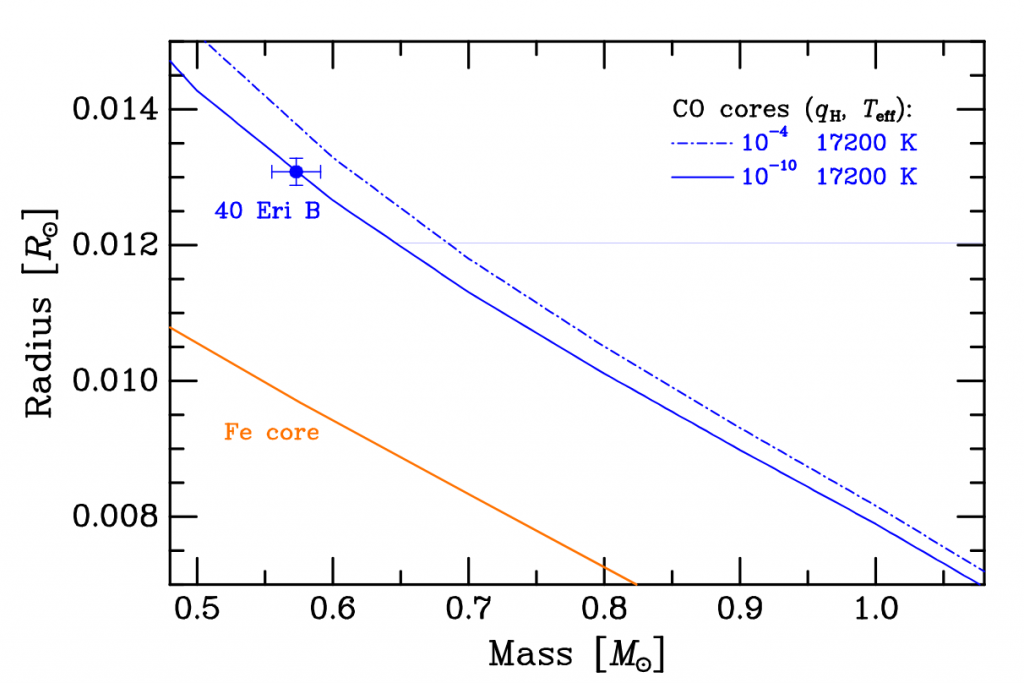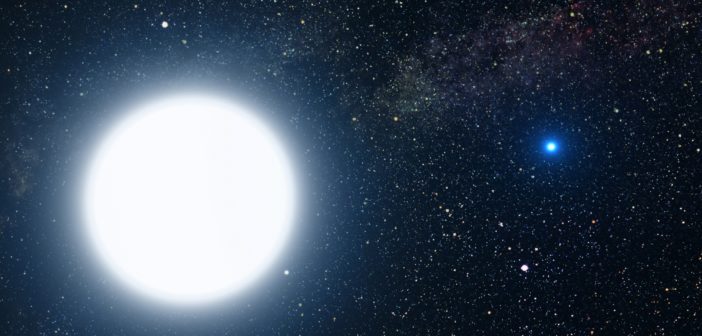Editor’s note: Astrobites is a graduate-student-run organization that digests astrophysical literature for undergraduate students. As part of the partnership between the AAS and astrobites, we repost astrobites content here at AAS Nova once a week. We hope you enjoy this post from astrobites; the original can be viewed at astrobites.org!
Title: Astrophysical Implications of a New Dynamical Mass for the Nearby White Dwarf 40 Eridani B
Authors: Howard E. Bond, P. Bergeron, A. Bedard
First Author’s Institution: Pennsylvania State University
Status: Accepted to ApJ, open access
About a hundred years ago, one particular star made many astronomers scratch their heads. The star in question is 40 Eridani B, which is part of triple stellar system in the Sun’s neighbourhood, only 5.0 parsec away from us. It was classified as an A-type star by Williamina Fleming, one of the women computers working at the Harvard College Observatory. Fleming devised a system to classify stars according to the relative amount of hydrogen observed in their spectra, which was later improved by Annie Jump Cannon and is the basis of the system still in use. A-type, in particular, means that the star shows hydrogen as its most abundant element. This is usually a consequence of the star being so hot that molecules can’t stick together and metals are mostly ionised. As luminosity depends on temperature, this type of star is also very bright. 40 Eridani B, however, was too faint for a typical A star. A few years later, another faint star was also found to be of A-type: Sirius B, the companion to Sirius A, the brightest star in the sky. This suggested the existence of a new class of underluminous stars with spectra dominated by hydrogen.
You might have already guessed what they are, but it took astronomers back in the day a while to figure it out. Astronomer Willem Luyten was the first to refer to them as “white dwarfs”, back in 1922. These stars have already retired from the job of synthesising new elements, so there’s nothing to prevent gravity from acting and compressing them to a very small (about the size of Earth), extremely dense (a teaspoon of its material would weigh a tonne!) object. Unlike the typical A stars, the reason we can only detect hydrogen in their atmospheres is not their temperature, but the fact that their gravity is so strong that it pulls all the heavier elements to the core. As a result, they can be dominated by hydrogen and still be faint; thus, the mystery of the faint star was solved.
The Mystery of Core Composition
As our methods of measurement improved, astronomers were able to model the orbit of the stars in the system and use Kepler’s laws to constrain their mass. In 1974, astronomer W. D. Heintz obtained a mass of 0.43 times the mass of the Sun for 40 Eridani B. At the time astronomers already knew, however, that the lowest possible mass of a white dwarf that can be formed through single-star evolution — considering the present age of the Universe — is about 0.5 times the mass of the Sun. Any star that would form white dwarfs lighter than that should still be in the main sequence, calmly burning hydrogen into helium. So assuming the mass for 40 Eridani B was correct, it would have to be a helium-core white dwarf resulting from a binary-star merger. In this situation, the stars release energy when spiralling into each other, and this energy carries away material from the outer layers, allowing the formation of a lower mass white dwarf with a helium core.
A new mystery surrounding 40 Eridani B arose in 1998 when J. L. Provencal and collaborators estimated the radius of the star using parallax measurements. With the independent estimates of mass and radius for this and other stars, they proceeded to test the mass-radius relationship for white dwarfs (you can read more about it in this astrobite). They found that the combination of mass and radius of 40 Eridani B would be better explained by a core composed of a combination of magnesium and iron. So our theory of stellar evolution suggested the star had a helium core, while our theory of white-dwarf structure indicated a core composed of much heavier elements.
The Mystery of Heavier Mass
The plot thickened in 2012 when N. Giammichele and collaborators estimated the mass of 40 Eridani B using a model atmosphere analysis. This consists of comparing the spectrum of the star to model spectra derived from atmospheric models to obtain temperature and gravity, and subsequently estimating the mass of the star adopting a theoretical mass-radius relationship. This is by far the most widely used method to estimate the mass of white dwarfs, so we expect it to be reliable. Hence astronomers were very surprised to find that this method yielded a mass of 0.59 solar masses for 40 Eridani B, inconsistent with the mass derived from the orbital analysis. Now our theory of stellar evolution seemed to be clashing with our theory of stellar atmospheres as well.
Which theories should be revised? The authors of today’s paper have the answer.
More Data!
The authors were very surprised to discover that the orbit of 40 Eridani B had not been updated with new observations over the more than four decades since the work of Heintz. They contacted the binary star group at the United States Naval Observatory (USNO), which in turn assembled all the data they could find containing this star. With these new measurements, the group found a smaller orbital period, which led them to obtain a much higher mass for 40 Eridani B than Heintz: 0.573 solar masses.

Figure 1: The position of 40 Eridani B in a mass-radius plane given the new derived values for mass and radius is marked by the blue circle. The orange line shows the mass-radius relationship for an iron core, which was needed to explain previous estimates of mass and radius, but is very far from the new ones. The blue lines show the relationship assuming a carbon-oxygen core. The dash-dot line is for a thick hydrogen atmosphere, while the solid line, which agrees better with the data, assumes a thin hydrogen atmosphere. [Bond et al. 2017]
About the author, Ingrid Pelisoli:
I am a third year PhD student at Universidade Federal do Rio Grande do Sul, in Brazil, and currently a visiting academic at the University of Warwick, UK. I study white dwarf stars and (try to) use what we learn about them to understand more about the structure and evolution of our galaxy. When I am not sciencing, I like to binge-watch sci-fi and fantasy series, eat pizza, and drink beer.

1 Comment
Pingback: 40 Eridani B: A Challenging Star – MeasurementDataBases for Industry & Science